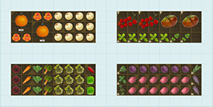How to grow Artichoke (Annual)?
- Latin Family: Asteraceae
- Latin Genus: Cynara
- Ease of Growing: Moderate
- Growing Type: Annual
Artichokes are considered to be one of the ultimate vegetables. No other vegetable is quite as decadently delicious when cooked fresh from the garden. This is somewhat ironic, when you consider that it is actually a type of Thistle. The sprawling plants need a lot of space, so the yield per square foot is very low. In a suitably mild and moist climate they are perennial, often yielding for 5 years or more. In colder regions, artichokes should be treated as annuals as the roots will die with prolonged freezing. They are also quite low maintenance and need almost no attention.
Videos
Artichoke (Annual) History
Globe Artichoke is a native of the Mediterranean, where its flower buds have been a favored food since the time of ancient Greece. They are quite a unique vegetable in that the part eaten is actually a part of the flower (the scales and swollen base).
Soil Preference
- PH (min/max): 5.5 - 7.0
- PH Ideal (min/max): 6.0 - 6.5
To produce the highest quality Artichoke hearts you need a deep, rich, well-drained, sandy soil. Drainage is particularly important in cold climates because if the roots stay wet for long periods in winter they will often rot.
How to care for Artichoke (Annual)?
True to its Thistle nature, the Artichoke is a vigorous and robust plant that needs little attention once established. Its only real weakness is its lack of tolerance to cold weather.
Water
Though relatively drought tolerant, Artichokes yield better if the soil is kept evenly moist. Water is especially crucial when the buds are developing.
Fertilizer
Artichokes are most productive when grown without any check in their growth, which means they must get all the nutrients they need. They are usually fed annually with a mulch of compost or aged manure. You can also use an occasional foliar feed of [compost tea] or liquid kelp.
Seeds
Seed Viability: 6 - 10 years
Germination Percentage: 60.0
Saving Artichoke seed is pretty easy, but it is rarely done because they are normally propagated vegetatively. If the flowers are allowed to mature, seed is produced readily, as one flower can pollinate another on the same plant (though not itself). It sometimes self-sows itself vigorously and can become a pest.
Light
Sun: min. 6 hours daily
Artichokes are native to the Mediterranean and need full sun for best growth.
Conditions:Cool, Warm
Season:Long Season
Storage
Artichoke hearts may be canned for an out-of-season treat. Store at room temperature in the pantry.
Storage Req: Canning
Storage Temp: 60-70°F
Storage Length: 1-180 days
The hearts will keep for a week or so in the vegetable drawer in the fridge. Don't rinse or cut before storing. As with any vegetable they are best eaten as fresh as possible.
Storage Req: Refrigerator
Storage Temp: 35-40°F
Storage Length: 5-10 days
Problems
Aphids
Artichokes are not seriously bothered by disease or pests, though aphids can sometimes be a problem (hose them off with a strong jet of water).
Artichoke (Annual) Types
- Used for moving varieties into a new Category
- Globe
In colder areas with severe winters, you should grow Artichokes as annuals. Seed varieties found in this category are great for annual cultivation, and produce well in their first year.
Artichoke is considered to be one of the ultimate vegetables. No other vegetable is quite as decadently delicious when cooked fresh from the garden. This is somewhat ironic when you consider that it is actually a kind of Thistle. The sprawling plants need a lot of space, so the yield per square foot is very low. They are also quite low maintenance and need almost no attention.
Pests
- Aphids
- Leafminers
- Deer
- Whiteflies
- Armyworms
- Gophers
- Slugs and snails
Diseases
- Crown Rot
- Damping Off
- Powdery Mildew
- Verticillium Wilt
